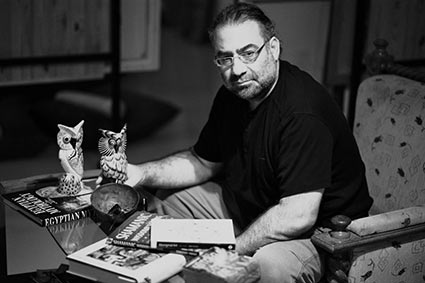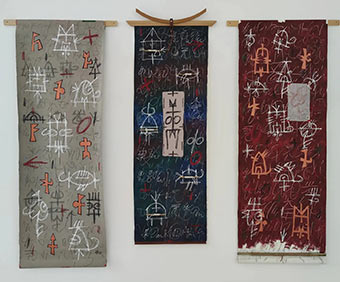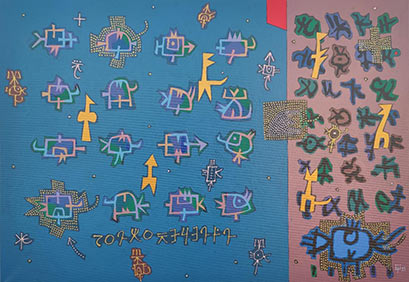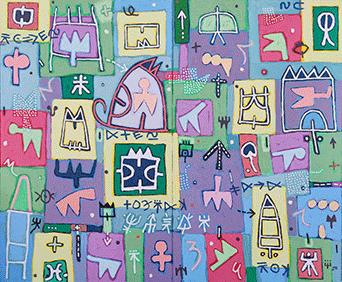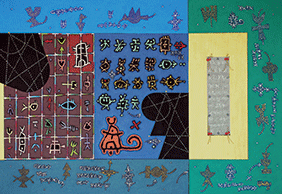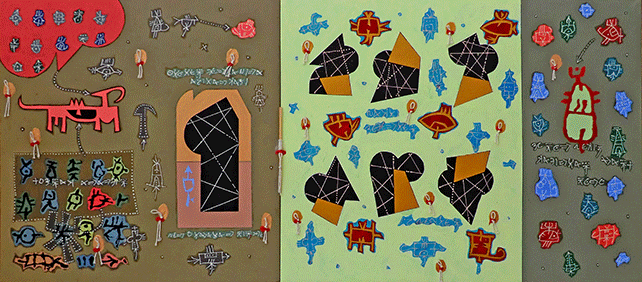UMIT INATCI - MORPHOLOGIES OF THE ANTHROPOGENESIS VERSUS COSMOGENESIS
It was foreseeable —by linguistic coherence— that Umit Inatci, after his pictorial phase based on alphabets and ideograms of his own creation which has granted him the framework for an imaginary and symbolic original system, would progress to a semantic anthropological phase; to an Art, that is to say, created from the activities, the rituals, the conditions and predispositions besides the materials produced by the daily flow of human actions. The field, to which he would direct his research, was foreseeable, though his methods remained unpredictable. Here is the day, after a few years of grappling with them, that they come to light—alongside his by now established repertoire of paintings whose distinguishability has a characteristic value belonging to a culture and a tradition contendently Mediterranean— new morphologies from his repertoire’s appearance, where is possible to pinpoint a great quantity of connections from an ethnographic and ritual magical past originated in wider areas than his motherland. Often, as a matter of fact, in these works you can recognize emblems, materials, objects, praxis’ processes that seems shamanic coming from liturgies which recall archaic ceremonial propitiatory apotropaic sessions, primitive artifacts, in the epochal sense, not technical of course, all re-invoked with new assembled forms praised and reexamined in the memory of this Homo faber Inatci the artist.
Works like Hieros Gamos Ritual, 2011, with wooden axis, canvas, cloth, leather, earthly golden colours, draw forth alchemical methods within an assemblage nearly symmetrical lavish with resonances; the examples of Inatci’s art are varied and count for his research’s scope and depth that could be better described as ‘findings’ within an active memory, his own, which is really founded and constructed with the responsible care of a maker or scholar.
The presence in the mediterranean area, of an artist like Umit Inatci, it’s a resource not exclusively for the art and culture of the entire island of Cyprus, which has given it a substantial contributions to its growth, indeed cultural as well as social, but also to those countries where he has worked and left traces of his activities, from Italy to northern Europe.
Immediate and effortless because authentic and wellspring, Inatci’s imaginative vein offers in this new expositive occasion, a kaleidoscopic show of both his pictorial and sculptural prolific inventions. I had already admired at birth, appropriately about twenty years ago, his first experiences that today I observe once again, those chasms of the wide cycle of creation from the anthropological coefficient that during the years 2000 reinforced his poetics.
In truth, it’s all concerning a metamorphosis of the signs and initial figures – they are already apparent in the original residing culture – with marks and material forms, physically lived and employed again in new organisms that Inatci has provided with multiple prismatic meanings. Therefore, it is an art, which examines anthropology while being deeply rooted in the discipline of art making and its historical complexity.
Works like Opus Magnum, 2002, early in the line with Hieros Gamos Ritual which has already being mentioned, evoke in our vision the alchemical experience; just like Lingam, 2010, could be combined with The Dream of Hermaphrodite, 2019, or Vitam et Mortem, 2011, has an implicit connection with the version of Narcisse, 2015 – all things considered – equally thanatological, it conjures the myth of the tragic figure in love with his own image.
In Inatci’s art the congenital narrative figure, attributable to the space of a mosaic type, sporadic, made with emblems and monograms that could, with a symphonic willpower, reach a poem’s vast breath as in the case of Untitled, 2019 (80x260 cm) a real polyptych which improves, in its dimensions, the already ample tryptic Untitled, 2019, (50x150 cm).
If the painting of the early years could seem monologic, the current one is overtly multilogical and within it diverse chromatic, monochromatic and differently drawn fields – some black like dark cosmic breaches – can be found, wherein their geometry they cut, as geometrically drawn, tracing simultaneous opposite directions, towards an improbable and enigmatic ‘where’. Nevertheless, the narration is always merry and happy thanks to the uninhibited colors used like the ones found in the folk productions of a young Kandinsky.
Coming back to the pictorial-sculptural works’ cycle of clear anthropological mold, it’s hard to keep silent on a series of successful micro-cosmogonies like Untitled, 2011 (felt, wood, chicken legs, wax, gauze, straw, twine, glass, feather) or Untitled, 2011 (felt, copper, bone, twine, chicken legs, terra cotta, hedgehog spines, feather, and leather). Similarly with the challenging Untitled, 2011 (180x240 cm) whereas the taxonomic practices combined with the ‘shelving’ structure with ‘loci’ and ‘imagines agentes’ evoke the memory theatres invented in the sixteencentury (from Ramon Llull to Giulio Camillo).
The lesson of this still young ‘Maestro’ is not isolated from a context, for that matter rather significant, which includes personalities like Joseph Beuys, Paul Thek, Claudio Costa, Michelangelo Pistoletto, Jannis Kounellis, James Lee Byars, all artists encountered in his path during the years of pioneering experiences (and some even acquainted with during his life) whom Inatci knew how to assimilate and declare from, on his own, in his way of constructing a personal idiom as efficient, poetic and distinguished.
Umit Inatci is a poet of images and words, about manners and ethics. That’s why at the end of his narration, he doesn’t spare us the aching notes of Goya version works like Atrocity and Amnesia, 2017, as telling as harshly current. Being an artist today means testifying, more than in any other moment, the man, while in other places the dissolution of the subject is still being addressed. Other works like sacrificial emblems (like in Curse of Sacrificial Ram, 2019), together with furnishing and animal remains and mostly binding, speak and signify the will to not forget, to hold everything together living in memory, like a religious sentiment (from the latin religo = holding together) or, if you prefer, the sacred of existence.
Città di Castello, 4 January 2020



